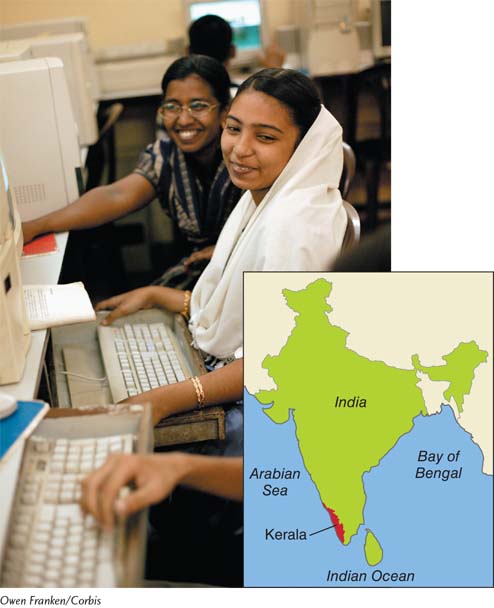working toward  sustainability
sustainability
Gender Equity and Population Control in Kerala
India is the world’s second most populous country and will probably overtake China as the most populous before 2030. Since the 1950s, India has tried various methods of population control, steadily reducing its growth rate to the current 1.5 percent. Although this growth rate would suggest below-
In the 1960s, India attempted to enforce nationwide population control through sterilization, but massive protests against this coercive approach led to changes in policy. Since the 1970s, India has emphasized family planning and reproductive health, although each Indian state chooses its own approach to population stabilization. Some states have had tremendous success in lowering growth rates. Kerala, in southwestern India, is one of those states.
The state of Kerala is about twice the size of Connecticut. But Connecticut has a population of roughly 3.5 million people while Kerala has a population of more than 30 million. Kerala’s population density is about 820 people per square kilometer (2,100 people per square mile), almost 3 times that of India as a whole, and 25 times that of the United States. Until 1971, Kerala’s population was growing even faster than the population in the rest of India, in large part because the state government had implemented an effective health care system that decreased infant and adult mortality rates.
Since 1971, Kerala’s birth rate, like its mortality rate, has fallen to levels similar to those in North America and other industrialized countries. The current total fertility rate in Kerala is about 2.0—

A special combination of social and cultural factors seems to be responsible for Kerala’s sustainable population growth. Kerala has emphasized “the three Es” in its approach: education, employment, and equality. In addition to its accessible health care system, Kerala has good schools that support a literacy rate of over 90 percent, the highest in India. Furthermore, unlike rates in the rest of India, male and female literacy rates in Kerala are almost identical. In other parts of India and in most other developing countries, women attend school, on average, only half as long as men do. As we have learned, higher education levels for women lead to greater female empowerment and increased use of family planning. In Kerala, 63 percent of women use contraceptives, compared with 48 percent in the rest of India, and many women delay childbirth and join the workforce before deciding to start families. Kerala has a strong matriarchal tradition in which women are highly valued and their education is encouraged. Education and empowerment allow these women to be in a better position to make decisions regarding family size.
The World Bank estimates that if the rest of the developing world had followed Kerala’s lead 30 years ago and equalized education for men and women, current TFR throughout the developing world would be close to replacement-
Critical Thinking Questions
Name some typical ways countries have tried to lower birth rates.
What are some other innovative ways to lower birth rates?
Can achieving replacement-
level fertility sometimes cause difficulties? If so, describe some problems that might occur. What is preventing the model used to promote slower population growth in Kerala from being used elsewhere in the world?
References
Franke, R. W., and B. H. Chasin. 2005. Kerala: Radical reform as development in an Indian state. In The Anthropology of Development and Globalization: From Classical Political Economy to Contemporary Neoliberalism, ed. M. Edelman and A. Haugerud. Blackwell.
Pulsipher, L. M., and A. Pulsipher. 2011. World Regional Geography. 5th ed. W. H. Freeman.